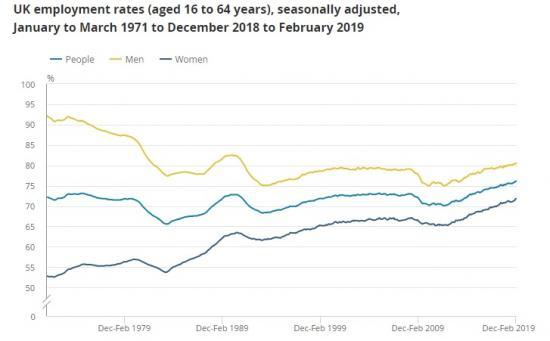Record Employment Rates In UK Continue Upward Surge
16th April 2019

Source: Office for National Statistics - Labour Force Survey.
The UK employment rate was estimated at 76.1%, higher than for a year earlier (75.4%) and the joint-highest figure on record.
The UK unemployment rate was estimated at 3.9%; it has not been lower since November 1974 to January 1975.
The UK economic inactivity rate was estimated at 20.7%, lower than for a year earlier (21.2%) and the joint-lowest figure on record.
Excluding bonuses, average weekly earnings for employees in Great Britain were estimated to have increased by 3.4%, before adjusting for inflation, and by 1.5%, after adjusting for inflation, compared with a year earlier.
Including bonuses, average weekly earnings for employees in Great Britain were estimated to have increased by 3.5%, before adjusting for inflation, and by 1.6%, after adjusting for inflation, compared with a year earlier.
Estimated employment rates for men and women aged between 16 and 64 years have been generally increasing since early 2012. For December 2018 to February 2019, the employment rate:
for all people was estimated at 76.1%, the joint-highest since comparable records began in 1971
for men was estimated at 80.5%; it has not been higher since December 1990 to February 1991
for women was estimated at 71.8%, the joint-highest since comparable records began in 1971
The increase in the employment rate for women in recent years is due partly to changes to the State Pension age for women, resulting in fewer women retiring between the ages of 60 and 65 years.
Estimates for December 2018 to February 2019 show 32.72 million people aged 16 years and over in employment, 457,000 more than for a year earlier. This annual increase of 457,000 was due entirely to more people working full-time (up 473,000 on the year to reach 24.15 million). Part-time working showed a small fall of 15,000 on the year to reach 8.57 million.
Unemployment rates have been generally falling for the last five years.
Unemployment measures people without a job who have been actively seeking work within the last four weeks and are available to start work within the next two weeks. The unemployment rate is the proportion of all employed and unemployed people (not the proportion of the total population) who are unemployed.
Estimated unemployment rates for both men and women aged 16 years and over have been generally falling since late 2013.
For December 2018 to February 2019, the unemployment rate:
for everyone was estimated at 3.9%; it has not been lower since November 1974 to January 1975
for men was estimated at 4.1%
for women was estimated at 3.8%, the joint-lowest since comparable records began in 1971
For December 2018 to February 2019, an estimated 1.34 million people were unemployed, 76,000 fewer than for a year earlier and 914,000 fewer than for five years earlier.
Since comparable records began in 1971, the economic inactivity rate for all people aged from 16 to 64 years has been generally falling (although it increased during recessions). This is due to a gradual fall in the economic inactivity rate for women.
For people aged from 16 to 64 years for December 2018 to February 2019, the economic inactivity rate:
for all people was estimated at 20.7%, the joint-lowest figure since comparable records began in 1971
for men was estimated at 16.0%; it has not been lower since May to July 2003
for women was estimated at 25.3%, the joint-lowest figure since comparable records began in 1971
Estimates for December 2018 to February 2019 showed 8.54 million people aged from 16 to 64 years not in the labour force (economically inactive). This was:
213,000 fewer than for a year earlier
456,000 fewer than for five years earlier
the lowest since January to March 1993
Earnings in real terms (that is, adjusted for inflation) is calculated as nominal earnings (that is, not adjusted for inflation), deflated by the Consumer Prices Index including owner occupiers' housing costs (CPIH).
Between December 2017 to February 2018 and December 2018 to February 2019 for employees in Great Britain:
regular pay was estimated to have increased by 3.4% in nominal terms and by 1.5% in real terms
total pay was estimated to have increased by 3.5% in nominal terms and by 1.6% in real terms
The estimated number of vacancies in the UK fell sharply during the recession of 2008 to 2009 but has increased steadily since 2012. For January to March 2019 there were an estimated 852,000 vacancies in the UK, 32,000 more than a year earlier.
CBI SCOTLAND RESPONDS TO LATEST LABOUR MARKET STATISTICS
CBI Scotland has responded to the latest ONS labour market statistics for Scotland from December 2018 to February 2019.
Tracy Black, CBI Scotland Director, said:"Even amid Brexit uncertainty and Scotland's ongoing struggle to attract people and skills, the Scottish labour market continues to move in the right direction.
“While unemployment has dropped once again, and more people are finding work, we can’t afford to rest on our laurels. Addressing weak productivity levels is imperative to securing a long-term boost to living standards and economic prospects. Among other measures, that means making the education and skills system more reflective of the needs of modern business."
